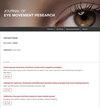Potential of a laser pointer contact lens to improve the reliability of video-based eye-trackers in indoor and outdoor conditions
IF 1.3
4区 心理学
Q3 OPHTHALMOLOGY
引用次数: 0
Abstract
Many video-based eye trackers rely on detecting and tracking ocular features, a task that can be negatively affected by a number of individual or environmental factors. In this context, the aim of this study was to practically evaluate how the use of a scleral contact lens with two integrated near-infrared lasers (denoted CLP) could improve the tracking robustness in difficult lighting conditions, particularly outdoor ones. We assessed the ability of the CLP (on a model eye) to detect the lasers and to deduce a gaze position with an accuracy better than 1° under four lighting conditions (1 lx, 250 lx, 50 klux and alternating 1lx /250 lx) on an artificial eye. These results were compared to the ability of a commercial eye tracker (Pupil Core) to detect the pupil on human eyes with a confidence score equal to or greater than 0.9. CLP provided good results in all conditions (tracking accuracy and detection rates). In comparison, the Pupil Core performed well in all indoor conditions (99% detection) but failed in outdoor conditions (9.85% detection). In conclusion, the CLP presents strong potential to improve the reliability of video-based eye-trackers in outdoor conditions by providing easy trackable feature.激光笔隐形眼镜提高视频眼动仪在室内和室外条件下可靠性的潜力
许多基于视频的眼球跟踪器都依赖于检测和跟踪眼球特征,而这一任务可能会受到许多个人或环境因素的负面影响。在这种情况下,本研究旨在实际评估使用集成了两个近红外激光器的巩膜隐形眼镜(简称 CLP)如何提高在困难照明条件下(尤其是室外条件下)的跟踪稳健性。我们评估了在四种照明条件(1 lx、250 lx、50 klux 和交替 1lx /250 lx)下,人工眼球上的 CLP(在模型眼上)探测激光和推断注视位置的能力,精确度优于 1°。 这些结果与商用眼球跟踪器(Pupil Core)对人眼瞳孔的检测能力(置信度大于等于 0.9)进行了比较。相比之下,Pupil Core 在所有室内条件下都表现出色(检测率达 99%),但在室外条件下却失败了(检测率仅为 9.85%)。
本文章由计算机程序翻译,如有差异,请以英文原文为准。
求助全文
约1分钟内获得全文
求助全文
来源期刊

Journal of Eye Movement Research
OPHTHALMOLOGY-
CiteScore
2.90
自引率
33.30%
发文量
10
审稿时长
10 weeks
期刊介绍:
The Journal of Eye Movement Research is an open-access, peer-reviewed scientific periodical devoted to all aspects of oculomotor functioning including methodology of eye recording, neurophysiological and cognitive models, attention, reading, as well as applications in neurology, ergonomy, media research and other areas,
 求助内容:
求助内容: 应助结果提醒方式:
应助结果提醒方式:


